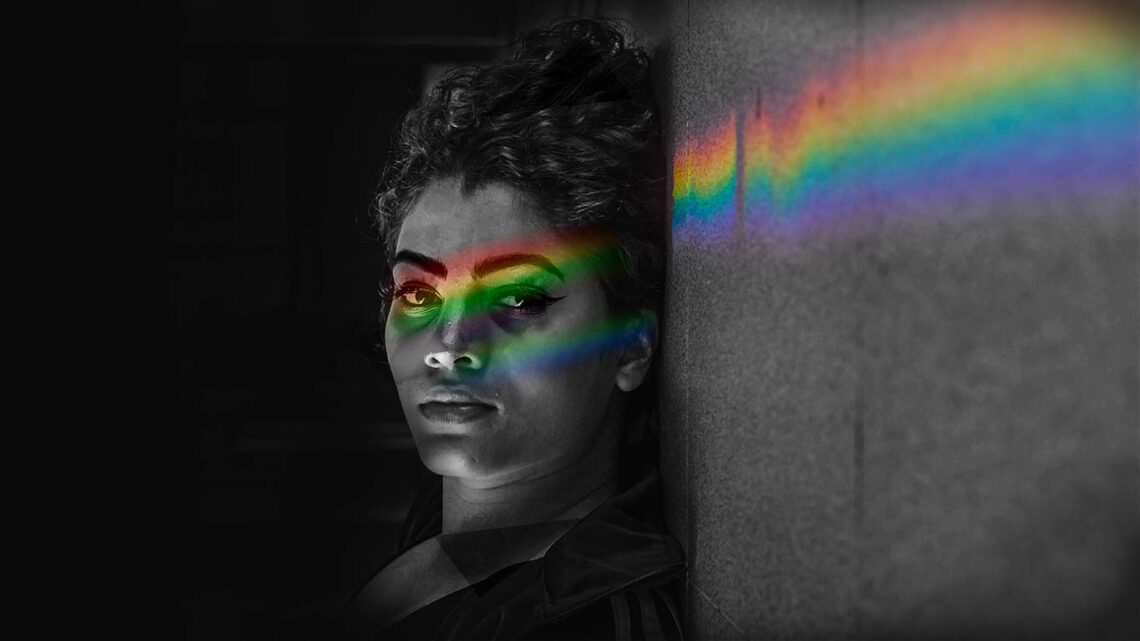by manmit and Manu
Content notes: includes examples of transphobia, homophobia, queerphobia, and casteism.
Trigger warning: Rape and violence.
In this series, we ask a few questions.
Is the Sikh panth working to create Sikh spaces (whether that be in our homes, organizations, institutions, initiatives, movements, communities, gurdwaras, or an imagined Khalistan) that are based on the vision set forth by the Gurus? Are we creating Sikh spaces which are truly equal and facilitate the spiritual growth of every person? Ultimately, are we developing Sikh spaces where Dalits, queer, and trans folks can find liberation and equality?
Or, are we continuing the legacy of casteism, queerphobia, and transphobia in our spaces that continues to plague society at-large?
We are going to explore this very complex and heavy topic in three parts:
- Part 1: The Problem. In Part 1 (below) we will discuss discrimination, caste oppression, how the Sikh Gurus worked against casteism, and how casteism manifests today.
- Part 2: Who is a “Sikh”? Here, we will discuss how people use caste and cisheteronormativity to gate-keep Sikhi.
- Part 3: Moving Forward. Here we will discuss how we can move towards a gurmat-oriented society and practical ways to become more welcoming and loving as individuals and as a panth.
Words to Know
Realizing some folk may be unaware of some terminology, we start with some definitions to help understand the points we make:
Queer: Previously weaponized as a slur against those “deviant” from the established norms of gender and sexuality, queer now is a reclaimed political term for those disrupting the normalized standards of gender and sexuality.
Trans: When one’s gender expression and/or gender identity differs from the sex (and sets of expectations alongside) assigned at birth.
Dalit: Formally known as “untouchable,” Dalit refers to casteless peoples who are considered the lowest of the castes, who “continue to experience profound injustices including socioeconomic inequalities, usurpation of their land, rights, and experience brutal violence at the hands of the ‘upper’ Castes.” (https://www.equalitylabs.org/castesurvey)
Cisheterosexual: Those who identify as cisgender (gender expression and gender identity corresponding to assigned sex at birth) and heterosexual (attracted emotionally and sexually to the opposite sex).
Cisheteronormativity: The system that normalizes and privileges being cisgender and heterosexual.
Khalistan: The Sikh sovereignty movement for a separate Sikh nation from India.
We would like to start with a discussion of our positionalities and complicities so you can understand where we are coming from in writing this article. It is important for you to understand us and why we are putting forward the points we are. And as we ask you to also be cognizant of your positionalities and how they shape your perspectives, understandings, and limitations, it is only natural we start with an assessment of our own.
About Us
manmit
I was born in Punjab, India to a land-owning, Sikh, jatt, dominant (and hence r*pist, oppressor, and genocidal) caste family. I specifically use r*pist, oppressor, and genocidal to describe the jatt caste to call to attention the fact that the jatt caste has gained its domination through r*pe, oppression, and genocide of Dalit folks. In fact, as Amritpal Kaur writes, “for Jat boys, rape of a Dalit girl is considered to be a coming of age normal.” Furthermore violence against Dalits, especially sexual violence, is often exacerbated if not facilitate by the difference in political, social, economic power between jatts and Dalits, writes Jyoti Diwakar.
At around 10 years old, I moved to California, and became a settler on the Indigenous lands of Nisenan and Plains Miwok (which on colonial maps is known as Sacramento). Over the past few years, I have started to come to terms with my queerness and transness and identify as a queer, trans, non-binary Sikh. I also want to acknowledge that I am a Sikh with unkept and cut kesh.
manu
I was born in Punjab and immigrated at the age of 6 to California as a settler of the Indigenous land stolen from the Muwekma Ohlone Tribe. My parents were the first in my family lineage to immigrate here. As the child of Dalits, the trauma caused by casteism runs deep in my family. The intergenerational cycles of trauma caused by casteism have led to alcohol use disorder, domestic violence, mental illness, and abuse. I am also queer and non-binary, which has further strained the relationship I have with my biological family. Sikhi is a way for me to not only connect with my Guru but to also preserve the connection to culture and religion that has been bestowed upon me by my family.
It is imperative that I disclose my Dalit identity when I discuss caste based violence and discrimination because of power dynamics that continue to exist, even if folks try to unsee them. It is not possible for me to be casteist towards a jatt because reverse casteism does not exist, just as reverse racism against white people does not exist, as casteism is a system of violence on the basis of caste and at no point do I, as a Dalit, have a system to support me. You cannot take away the power of oppressors by mentioning your own oppression.
PART 1: THE PROBLEM
Discrimination Raises its Head
A few days ago, I (manmit) posted a question on Twitter: “Could any of our Gurus have been queer?” I had hoped this would open up discussions about queerness and transness within Sikhi. Instead of opening up discussions, the tweet started a fire on Sikh Twitter as hundreds of people came to engage with the tweet and me in very violent ways. There were folks who used queerphobic and transphobic rhetoric to reprimand me for daring to engage in queer speculations that placed queerness within Sikhi, with many targeting me for “blasphemy.” On top of that, the queerphobic and transphobic comments came alongside very violent casteist comments.
Similar to manmit’s experience, anytime I (manu) post a tweet or message pertaining to queerness and casteism in the Sikh community, I am attacked and people attempt to bully me into deleting my account.
In examining these tweets, we came to realize that most of these queerphobic, transphobic, and casteist comments were coming from cisheterosexual folks of jatt oppressor caste backgrounds, many of whom had “Khalistan” written in their bio.
This observation made us wonder, “What does this mean for marginalized folks within Sikh spaces? Whose freedom is prioritized and who is still oppressed and excluded from liberation?” And through this exploration, we want to propose that Sikh development and Sikh revolutions (whether it be creating Gurmat-inspired spaces or developing “Khalistan”) can’t be successful until we discuss liberation for everyone, especially for the most oppressed–the liberation of queer trans Dalit folks.
What is Caste Oppression?
Let’s start off by understanding casteim and how it interacts with Sikhi.
What is casteism?
Casteism is a rigid social system of hierarchy developed by brahmins in South Asia. It is based on the principle that humans are forever unequal and it entrenches human inequality by directing all aspects of life (Jagjit Singh). “At birth, every child inherits [their] ancestor’s caste, which determines social status and assigns ‘spiritual purity,” (Equality Labs).
The Sikh Gurus challenged brahmanism–which is loosely defined as a socio-religious ideology which serves the interests of the brahmin caste and its allies. Brahmanism engages in and perpetuates the process of human degradation through systems of privilege and punishments for upholding their preferred social order (Jagjit Singh).
The caste system became a self-propelled, automatic mechanism for downgrading groups and individuals. Although originally the system might have been initiated by color and racial prejudices against the Shudras ( lowest ranked of the four main castes of brahminism), and its main prejudices/discrimination/violence continues to be directed against them, social behavior gradually developed into an uncontrolled instrument of degradation taking down all those who fell within its easy reach (Jagjit Singh). It was people who were relegated into lower castes and women who suffered the most under this system.
Sikh Gurus Worked Against the Caste System
The Gurus shunned and condemned the caste system, caste ideology, and the social system based upon it, and sought to establish Sikhi outside the caste society. In this way, they used Sikh tenants as a base to challenge political and religious injustices and dominance of the time (Jagit Singh). We can see this in Gurbani:
As revealed to Guru Nanak Sahib Ji (Raag Sohee, Ang 730):
ਗਲੀ ਜੋਗੁ ਨ ਹੋਈ ॥ ਏਕ ਦ੍ਰਿਸਟਿ ਕਰਿ ਸਮਸਰਿ ਜਾਣੈ ਜੋਗੀ ਕਹੀਐ ਸੋਈ ॥੧॥ ਰਹਾਉ ॥
Religion does not consist in words, only one who looks on all people as equal is religious.
And Guru Amar Das Sahib Ji (Raag Bhairao, Ang 1127):
ਜਾਤਿ ਕਾ ਗਰਬੁ ਨ ਕਰਿ ਮੂਰਖ ਗਵਾਰਾ ॥ ਇਸੁ ਗਰਬ ਤੇ ਚਲਹਿ ਬਹੁਤੁ ਵਿਕਾਰਾ ॥੧॥ ਰਹਾਉ ॥
Do not be proud of your social class and status, you ignorant fool! So much sin and corruption comes from this pride.
We can also see the Gurus’ commitment to dismantle caste beyond Gurbani, and through their lived examples. For instance, Guru Nanak Sahib challenged caste discrimination against women. Guru Angad Sahib said, “there was no place in [my] congregation for anyone who observed caste” and demanded that all castes were treated as equals in their court. Guru Angad Sahib practiced this by serving langar to everyone on the same platform with the same food. Guru Amar Das Sahib went a step further and said no one could visit with them unless they took part in langar. Guru Gobind Singh Ji chose the Panj Piaré from different castes and during the Amrit ceremony, declared that all those joining the Khalsa should “consider their previous caste erased” and deem themselves of one family (Jagit Singh).
Casteism Today
While India’s constitution banned discrimination on the basis of caste and and while the Gurus made it clear there was no place for caste supremacy or hieracy, caste discrimination is unfortuantely still prevalent in Sikh spaces.
For instance, on Twitter, folks tried to “prove” (using Gurbani) that Sikhi is not actually anti-brahminical and claimed that simply talking about caste or brahmin supremacy is casteist against jatts or brahmins. Furthermore, it’s important to note that you don’t need brahmins to maintain brahmin supremacy; instead, the mechanisms of brahmin supremacy as a system are being reproduced by jatts in Punjab through caste supremacy.
For instance, caste tensions frequently erupt into physical and verbal violence between jatts and oppressed castes. Here are a few examples of how Punjabi jatts discriminate against oppressed castes (within and outside of India): cyber bullying, instigating violence at inter-caste marriages, discrimination at langar in gurdwaras, inquiring about one’s caste background to make academic admission or employment decisions, refusing to share water taps, refusing to make any physical contact, and refusing to eat food prepared by oppressed castes, (Human Rights Watch). In addition, the prevalence of caste is exemplified through the the gorss inequalities in land ownership between jatts and Dalits (India Spend), and the ways in which jatt pride is dominating the discourse on Kissan Morcha. This casteism has extended very deeply within Sikh spaces, allowing for a whole age during which caste oppressed folk were explicitly discriminated against within the Darbar Sahib too, such as being forbidden to offer karah prashad (The Wire).
Although jatts are not akin in caste level to brahmins, they are still agents of brahmin supremacy because they contribute to the violent oppression of people of oppressed castes. Under brahminism, it becomes the concern of every caste to improve its social status in the caste hierarchy. As the uplifting of a castes is extremely rare, castes would try to improve its social status by stigmatizing and lowering the position of other castes. So, every individual became personally involved in downgrading and degrading groups and individuals, as seen in these examples of jats discriminating against people of other castes (Jagjit Singh).
Be sure to read keep reading:
Part 2: Who is a “Sikh”? Here, we will discuss how people use caste and cisheteronormativity to gate-keep Sikhi.
Part 3: Moving Forward. Here we will discuss how we can move towards a gurmat-oriented society and practical ways to become more welcoming and loving as individuals and as a panth.
About the Authors
manmit singh chahal
manmit (they/them) is a student studying Comparative Ethnic Studies major with minors in Women’s and Gender Studies and Queer Studies. Currently working on graduating, they are applying for Ph.D. programs in Ethnic Studies, American Studies, Women and Gender Studies, and Feminist Studies.
manu kaur

Manu (they/them) works in neuroscience research and is a community organizer, educator, and advocate. They are a queer non-binary Dalit feminist committed to caste annihilation, queer liberation, and mental health activism. Their work is centered around advocating for caste oppressed communities, defending queer and trans lives, and dismantling the anti-Blackness that exists within the diasporic South Asian community. Manu dreams of a world that amplifies, uplifts, and protects Black, Dalit, queer, and trans lives.





1 Comment
Roopinder
01/25/2021 at 5:53 pmI come from a “Jatt Sikh” family. I follow the teachinings of the gurus. I do not have uncut hair nor am I Amrit Dhari. I as far as I am concerned, once you say you are Sikh, you can’t say you belong to any caste because those 2 things can’t be said in the same space. For me, a Jatt is a farmer or land owner. A Darji is someone who sews clothes. You can have a label for your profession but that does not mean one is higher than the other. We all work together to create society. We can’t survive without others and their expertise. One is not better than any other. This is what I have learned from my Guru. If you can’t follow the teaching of the first Guru of Sikhi, then you are not and can not call yourself a Sikh. Plain and simple. But humans are selfish, power hungry, always want to be at the top of the food chain. My family have not been farmers for 2 generations, so how am I a Jatt? How is a taxi driver, a teacher, a shop owner, a mill worker, a business owner a Jatt. Get off your high horse people and accept everyone as an equal and a child of god. Love and treat others as you would like to be treated. Open your mind and heart and you shall be a changed person. A true believer of my Gurus Sikhi.
